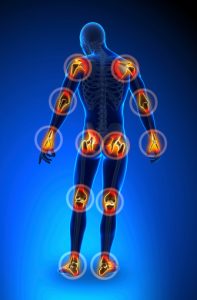 Living with persistent pain, such as arthritis pain, is always a challenge. You can manage occasional episodes of pain with quick go-to remedies like over-the-counter painkillers, but if the pain is chronic—meaning, it’s here to stay—you’ll need a long-term solution to continue functioning (and to do so in a safe manner) and still enjoy your life. In other words, you need to learn how to deal with pain day in and day out and adjust your lifestyle to include this new value into the equation.
Living with persistent pain, such as arthritis pain, is always a challenge. You can manage occasional episodes of pain with quick go-to remedies like over-the-counter painkillers, but if the pain is chronic—meaning, it’s here to stay—you’ll need a long-term solution to continue functioning (and to do so in a safe manner) and still enjoy your life. In other words, you need to learn how to deal with pain day in and day out and adjust your lifestyle to include this new value into the equation.
You may not like this idea, but in order to effectively transition into this new way of living, you’ll need to accept your pain as a family member. When you start living with someone, conflicts are unavoidable, but the longer you two co-exist under one roof, the more you become accustomed to each other and the better you get along. True, your relationship with pain is one-sided, but thinking of things this way should help you prepare for effectively handling pain in the long term without compromising your regular lifestyle.
Simple tips to manage arthritis pain
Advertisement
There are a few things to keep in mind when starting a pain management regimen. First of all, it’s just that: management. Don’t try to defeat or suppress your pain (you can make it worse and even develop joint deformities), but don’t go to another extreme and forgo all activity—joint disuse can result in stiffness. (A breakthrough secret that helps your joints feel young again.)
Always keep in mind how much stress your joints are receiving and how this stress is distributed. Some actions almost always stress the joints, for example, pushing, pulling, and twisting. Changing the way you perform an activity as well as thinking along the lines of weight distribution will help you protect your joints from damage.
Finally, just as you “joint-proof” your daily activities, you should also adapt your home and organize your routine to suit your needs and accommodate your aching joints. As mentioned, don’t try to go against all odds: how well you manage your pain largely depends on how well you adjust to it. (Make your joints more flexible in as little as five days.)
The recommendations below offer more specific pointers for living comfortably with arthritic pain:
If you’re doing something that causes you pain, change the way you do it. Take frequent rest and stretch breaks. Alternate between a light and moderate workload. Make use of adaptive equipment and proper gear.
Use large joints whenever possible, saving smaller joints for tasks that cannot be completed with larger joints. Carry grocery bags in an open palm instead of clenching fingers. Slide objects along the table or a counter instead of lifting them. When getting up from a seated position, engage your thigh muscles instead of using your arms to push off.
Protect your fingers. Avoid pinching or gripping for a long period of time. Don’t hold on to tools and handles with the same force as you’re used to.
Use your body more efficiently. If you need to pick up something on the floor, first bend your knees, and then stoop down. When in bed, use your abs to get up. When you’re driving, keep your hands below the “3 o’clock” and “9 o’clock” positions.
Re-arrange your work area. Get a good support for your back and feet. Raise your chair to make it easier to get up. An angled surface is more neck-friendly when you read or write. When standing, make sure that your work surface is high enough so that you don’t have to stoop over. Declutter your space and keep your supplies within a comfortable reach.
Take breaks. If your hands are involved, release your grip every 15 minutes. When driving long distances, get out of the car every hour or two to stretch. If you’re doing something repetitive, change your position every 20–40 minutes.
Advertisement
Lose weight. Any extra pounds translate into a strain on your lower back, hips, knees, and ankles. Slimming down should help relieve your pain.
As you can see, it’s all in the details. Simple adjustments like these can make your life easier and not as painful. Even if you don’t suffer from chronic pain, following these tips and keeping the above considerations in mind will help you protect your joints from damage and stress.
Related: Rheumatoid arthritis (RA): Causes, symptoms, and treatment
